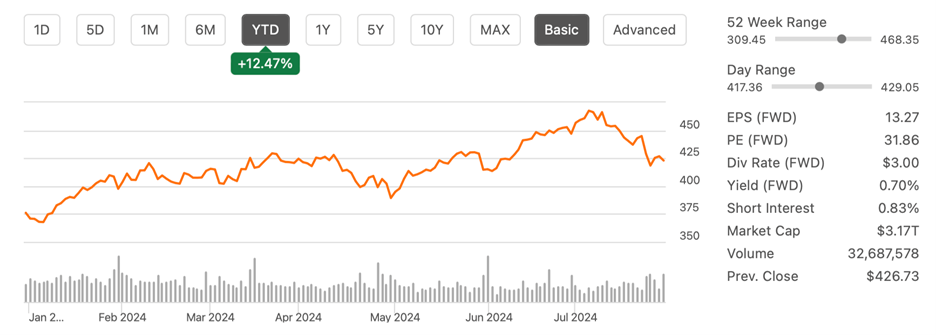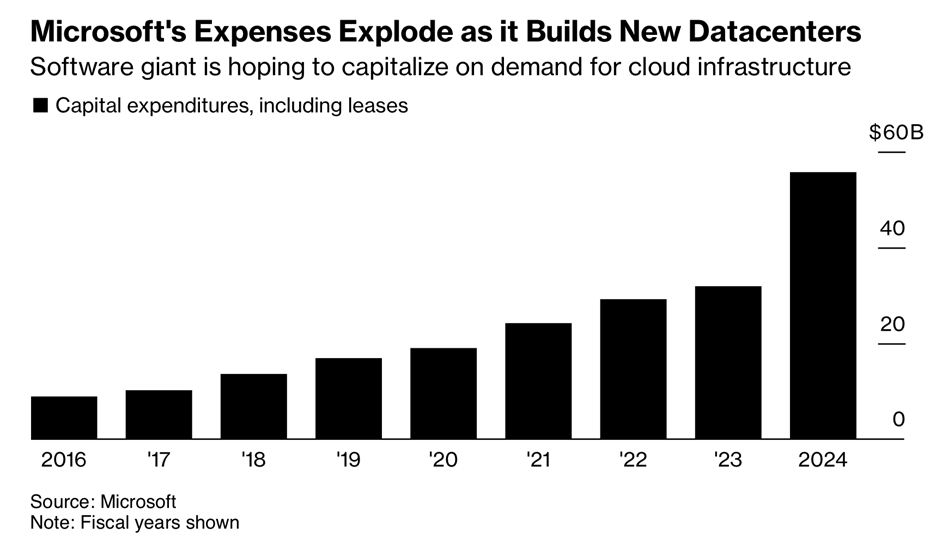Microsoft’s Shares Tumbled 6% Post Q4 Earnings: What Investors Need to Know?
July 31, 2024

- Microsoft’s Q4 2024 revenue grew 15% year-over-year to $64.73 billion, surpassing consensus expectations.
- Azure’s growth rate of 30% year-over-year, driven by AI integration, is expected to accelerate as capacity constraints ease in 2025.
- The company’s share price declined by 6% due to increased expenses and capacity constraints impacting Azure’s growth.

Source: SeekingAlpha
Microsoft’s recent financial results have turned heads, showcasing impressive growth despite some headwinds. However, the recent slowdown in Azure’s growth, compounded by ongoing capacity constraints and a sharp increase in expenses, has raised alarms, resulting in a 6% decline in Microsoft’s share price following the Q4 earnings release.

Source: Bloomberg
Here are some key insights from the software giant’s Q4 2024 earnings.
1. Strong Financial Performance
- Revenue Growth: Microsoft reported a total 4Q24 revenue of $64.73 billion, up 15% year-over-year, surpassing consensus expectations.
- Operating Margins: Operating margins were ahead of expectations, at 43.1%, signaling efficient cost management and robust profitability.
- Free Cash Flow: Although free cash flow fell short of internal estimates, it still outpaced consensus, indicating strong cash generation.
2. Azure’s Promising Future
- Azure Growth: Azure’s growth rate of 30% year-over-year was notable, even if it didn’t quite meet the lofty expectations. An easing of capacity constraints is anticipated to drive acceleration in the second half of 2025.
- AI Integration: Azure’s 8-point AI tailwind highlights Microsoft’s leading role in integrating artificial intelligence into cloud services.
3. Diverse Revenue Streams
- Gaming and Advertising: Xbox content and services saw significant tailwinds, and search and advertising growth exceeded expectations, driven by new product innovations.
- Office and Dynamics: Office Commercial growth was steady, supported by healthy renewals and the adoption of new features like M365 Copilot. Dynamics 365 also performed well, driven by new business wins.
Key Risks to Watch
1. Capacity Constraints
Microsoft’s growth, especially in Azure, has been hampered by capacity constraints. Although relief is expected in 2025, these constraints could impact near-term performance.
2. Capital Expenditure Concerns
Increased capex raises questions about the return on investment. While future growth is anticipated, the unquantified and uncertain pace of capex growth could worry investors.
3. Competitive and Regulatory Pressures
As a major player in tech, Microsoft faces intense competition and regulatory scrutiny, particularly in the U.S. and European Union. These pressures could impact its operational flexibility and profitability.
What Investors Need to Know?
Investors should note Microsoft’s strong strategic growth and AI investments. Our research partner has a price target of $480, reflecting the company’s potential. Valued at a 35 times of its enterprise value-to-free cash flow multiple on FY2026 estimates, Microsoft’s historical performance and AI-driven potential remain robust. As a leading AI beneficiary, Microsoft’s extensive portfolio in cloud computing, gaming, and productivity software ensures a stable revenue base and diverse growth opportunities. Monitoring capital expenditure developments and staying informed on regulatory changes are crucial, as these factors will significantly influence future growth trajectories and ROI. However, investors should be aware of potential cybersecurity vulnerabilities that could impact operations.
Technical analysis: Near-term weakness persists

Source: TradingView
MSFT has been trading in a clear uptrend, forming higher highs and higher lows from October 2022 lows. We are however seeing some signs of short-term weakness with MSFT breaking below its 50-day moving average. There was follow through to the downside, with RSI also failing to hold above 40.00, forming lower highs and lower lows showing signs of bearish confirmation. In the Post-market after earnings, we see MSFT continue its weakness, past prior swing lows. With the bearish confirmation and the weak post-market move, the door is open for MSFT to test towards supports near its 200-day moving average and the next bound of swing lows around $400.00. As such, MSFT could continue to face some weakness in the short-term. MSFT still however keeps a long-term uptrend with the continued formation of higher highs and higher lows. To see MSFT continue its upside, we would want to see initial support near $400.00 hold, and MSFT move above initial resistance levels near its 50-day moving average and its 38% Fibonacci extension level near $440.00.
Disclaimer: ProsperUs Head of Content & Investment Lead Billy Toh doesn’t own shares of the company mentioned.

Billy Toh
Billy is deeply committed to making investment accessible and understandable to everyone, a principle that drives his engagement with the capital markets and his long-term investment strategies. He is currently the Head of Content & Investment Lead for Prosperus and a SGX Academy Trainer. His extensive experience spans roles as an economist at RHB Investment Bank, focusing on the Thailand and Philippines markets, and as a financial journalist at The Edge Malaysia. Additionally, his background includes valuable time spent in an asset management firm. Outside of finance, Billy enjoys meaningful conversations over coffee, keeps fit as a fitness enthusiast, and has a keen interest in technology.







